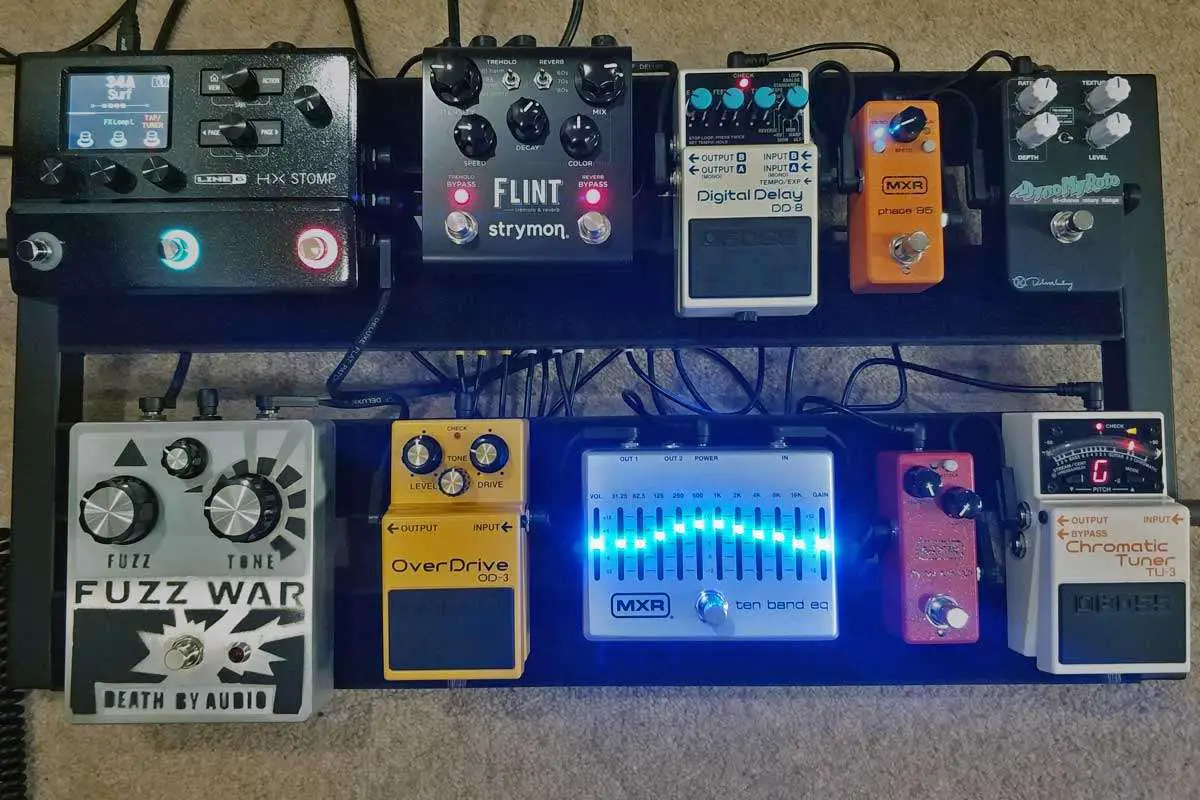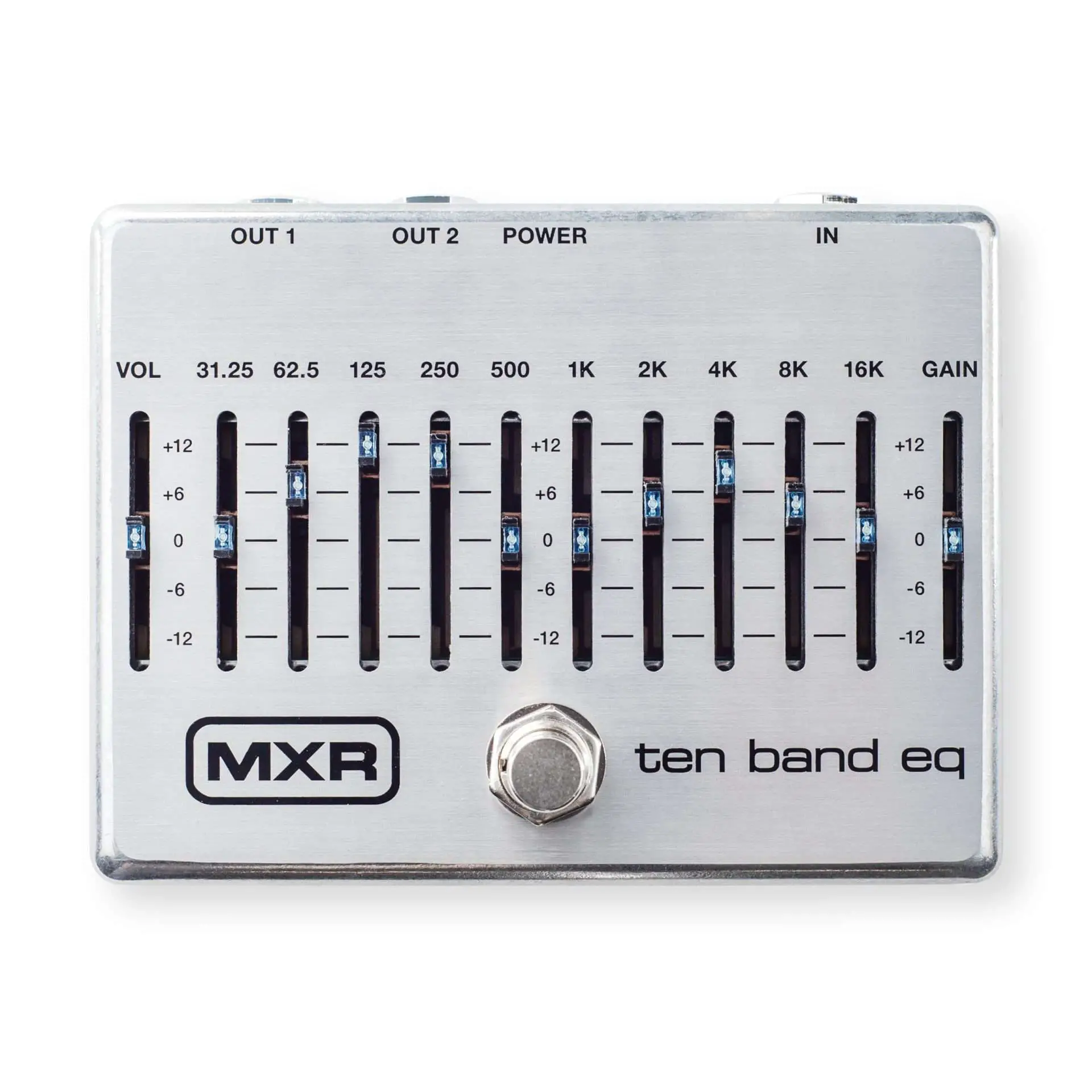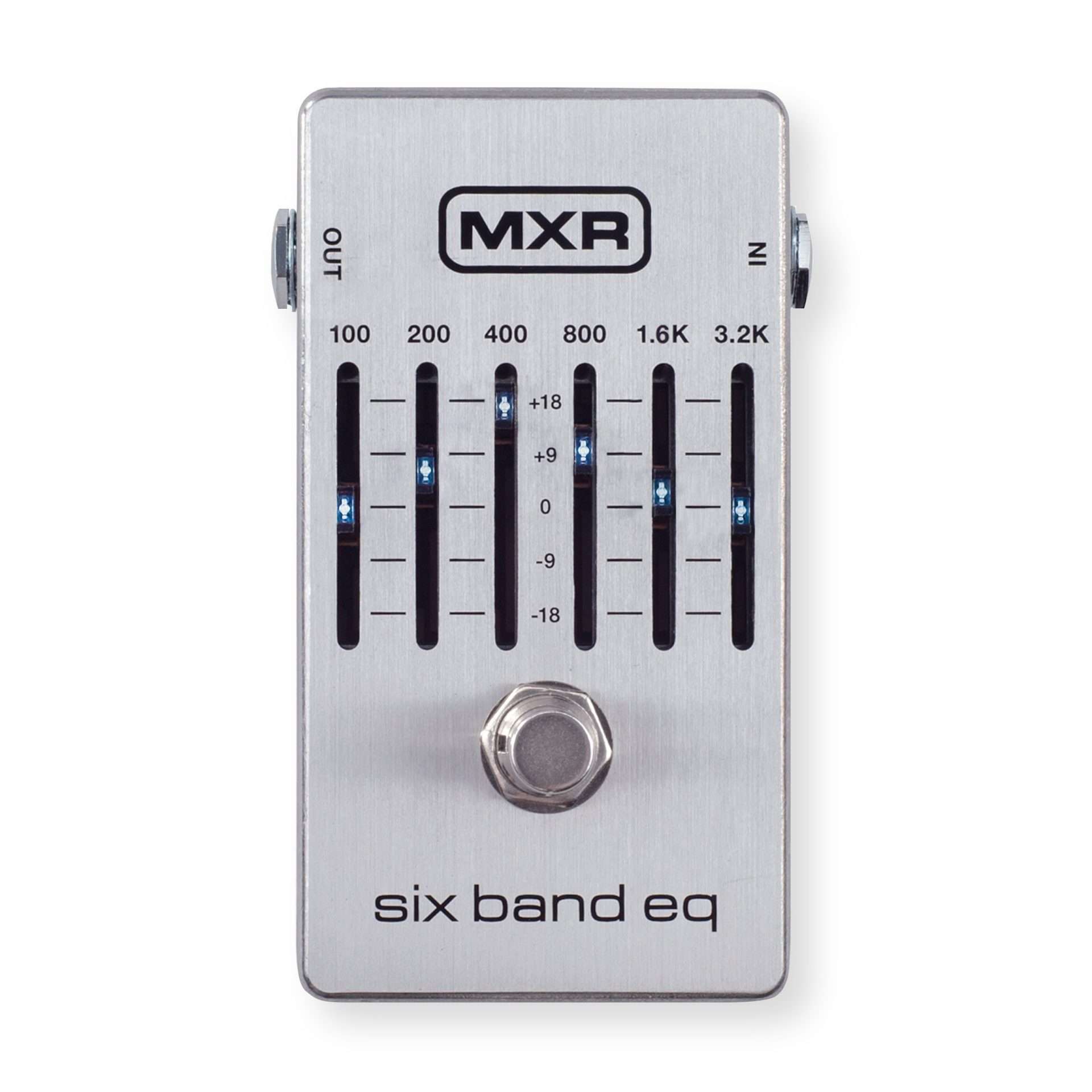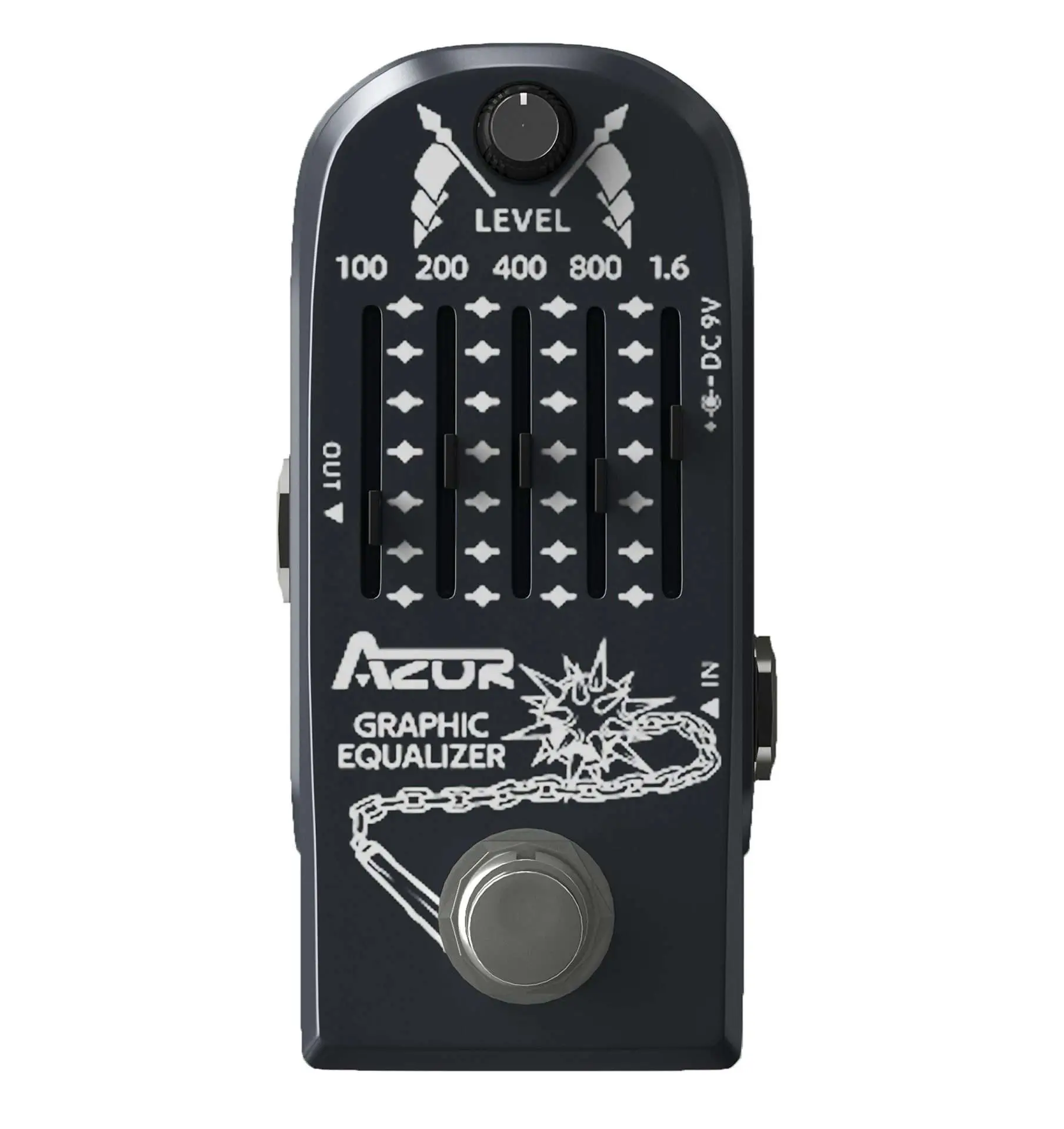Equalization, or EQ, is a crucial process in the realm of audio that involves adjusting the balance between frequency components. Choosing the best EQ pedal for you will be an invaluable tool if you’re looking to sculpt your sound in detail. These pedals allow you to fine-tune your tone by adjusting individual frequencies in order to fit in perfectly into a mix or stand out during a solo performance.
EQ pedals come in various forms, from simple fixed-frequency stompboxes to complex parametric or graphic equalizers offering fine control over a wide range of frequencies. They are particularly useful for guitarists and bassists, providing the ability to shape their instrument’s output – whether it’s to cut through a mix with bright, piercing highs or to warm up the sound with a frequency boost in the low-end.
When considering the purchase of an EQ pedal, critical factors include the number and types of frequency bands, the available frequency range, whether the pedal is digital or analog, and additional features such as built-in tuners or memory slots for preset EQ curves. The connectivity options, such as stereo or mono outputs, and the overall build quality are also important to ensure durability and consistent performance.
Choosing the best EQ pedal involves weighing these elements in the context of personal need and preference. We’ve conducted robust research and hands-on testing to find EQ pedals that not only meet a wide range of sonic demands but also stand out for their build quality, ease of use, and versatility.

Top EQ Pedals for Shaping Your Sound
We’ve selected a range of EQ pedals that stand out for their ability to fine-tune your audio spectrum. Whether you’re a guitarist looking to sculpt your tone with precision, a bassist desiring more control over your sound, or just in search of the perfect frequencies for your studio work, our list of EQ pedals is the gateway to your ideal sound setup. Each pedal offers unique features and capabilities, ensuring that you can find the perfect match for your musical needs and preferences.
MXR EQ Pedal

If you’re seeking tone control precision for your live or studio setup, the MXR Ten Band EQ is a pedal we highly recommend for its build and sound shaping capabilities.
Pros
- Allows meticulous sound shaping with ten frequency bands
- Sturdy construction and high-quality noise reduction circuitry
- Dual outputs for multiple signal paths add versatility
Cons
- The very bright LEDs may be overwhelming in darker settings
- Requires 18-volt power, which may not be ideal for all pedalboards
- Lack of presets means manual tweaking for every use
The moment we incorporated the MXR Ten Band EQ into our rig, it transformed how we approach tone shaping. With ten bands to play with, our capacity to fine-tune the sound for different rooms and setups felt unlimited. The build quality is solid, and the aluminum housing feels as though it can withstand the rigors of frequent use.
Having two outputs revolutionized our setup, allowing us to drive two separate signal chains, which in practice means more creativity in sound design or a quick switch between two amps. The inclusion of true bypass ensures that when the pedal is off, it doesn’t color our tone.
However, every pedal has its drawbacks. The LEDs are impressively bright, great for outdoor gigs, but nearly blinding in the studio or on darker stages. We also found ourselves wishing for the convenience of preset settings for quick tone changes between songs.
In summary, the MXR Ten Band EQ is a Swiss Army knife for anyone serious about their sound. It offers powerful tone sculpting in a robust package, though it may require a little adaptation for power needs and visual comfort on stage.
Boss GE-7 Equalizer

We believe the Boss GE-7 Equalizer is an essential tool for any guitarist looking to finely shape their tone with precision and ease.
Pros
- Intuitive sliders for easy frequency adjustments
- Sturdy construction withstands regular use
- Versatile tone shaping suitable for various music genres
Cons
- Pricier than some budget models
- 7 bands may not suffice for more intricate EQ adjustments
- Can be battery-heavy if not using an adapter
The moment we plugged in the Boss GE-7 Equalizer, we were greeted with seven bands of equalization that offer a substantial amount of control over the tonal output. The sliders move smoothly, allowing for quick adjustments on the fly, which is fantastic during live performances or studio sessions.
In our experience, the pedal boasts the rugged durability we’ve come to expect from Boss, suggesting it can take the wear and tear of gigging without any fuss. The case feels solid, and the faders are well-protected, which reassures us of its longevity.
As for sound shaping, we’ve found the GE-7’s capabilities genuinely enhance the guitar’s tone. Whether leveling out the sound for an acoustic set or pushing certain frequencies for a lead guitar’s stand-out moment, this pedal handles it all with finesse. It’s especially great for dialing in the mid-range to cut through a mix or reducing mud in the low-end.
While the GE-7 Equalizer comes at a higher cost compared to some entry-level options, we believe its reliable performance and build quality justify the investment. Additionally, those looking for more than seven bands may need to look elsewhere for even more detailed control, but for many, the available range is more than adequate.
The only slight snag we’ve noticed is that if you’re using batteries, they don’t last particularly long, making an external power supply a sensible addition. But as long as you’re prepared with either a power adapter or spare batteries, this should be a non-issue.
In conclusion, the Boss GE-7 Equalizer provides guitarists with powerful EQ control in a reliable, gig-ready format. Whether you’re tweaking your tone at home or making adjustments in a live setting, this pedal proves to be a valuable addition to any pedalboard.
MXR Six Band EQ

We’ve found this pedal perfect for sculpting sounds on stage with its precise sliders and durable design.
Pros
- Easily visible LED sliders for on-stage adjustments
- Significant tone shaping with ±18dB per band
- True bypass maintains signal integrity when disengaged
Cons
- Six frequency bands may be limiting for some
- No power adapter included
- Position of the power jack may not suit all pedalboards
When we got our hands on the MXR Six Band EQ, the immediate standout feature was its robust aluminum housing. This pedal has the heft and build that reassures you it’s going to endure countless gigs and travel, without adding too much weight to your rig.
Adjusting tones in a live setting can be a challenge, but with this EQ’s brightly lit LEDs, it’s a breeze to see and tweak settings, even in the dimmest lighting conditions. The sliders are responsive, providing exactly the right amount of resistance so you can make precise adjustments without worrying about them sliding out of place.
True bypass switching is a crucial feature for us, ensuring that when the pedal isn’t in use, it doesn’t interfere with the guitar’s signal. The MXR Six Band EQ delivers exactly that, preserving authentic guitar sounds when bypassed and offering powerful tone enhancements when in use. However, it’s important to note that with only six bands, some may find its range limiting compared to EQ pedals with more frequency options. Additionally, the absence of a power adapter means you’ll need to source one separately. Lastly, for those of us with tightly arranged pedalboards, the side-positioned power jack might require some rearranging.
Overall, our collective experience with this pedal has been overwhelmingly positive – those sliders shape our sound with finesse, providing a level of control that’s both impressive and intuitive. Whether at home, in the studio, or on stage, the MXR Six Band EQ has proven to be an asset, enhancing our sound without coloring it – unless, of course, that’s the intention.
JOYO 10 Band EQ

We believe the JOYO 10 Band EQ pedal is a versatile tool for refining your sound, offering both significant tonal control and a visually appealing design.
Pros
- Enhances the tonal range for various instruments
- Individual volume control promotes precise sound leveling
- Ambience lights add to the aesthetic appeal on stage
Cons
- May require the purchase of a separate power adapter
- LED lights could be overwhelming in a dimly lit setting
- Some users report unwanted noise at high volume levels
Finding the perfect EQ pedal that offers both versatility and precise tone shaping can be a challenge, but JOYO’s 10 Band EQ might just be the solution we’ve been seeking. My recent use of this pedal has allowed me to fiddle with the frequencies across my bass and guitar, and the wide range from 31.25Hz to 16kHz faithfully captures the ranges needed for both four-string and extended-range instruments. The independent volume knob is a thoughtful addition, providing extra control over the instrument’s output, ensuring it fits impeccably in the mix.
The futuristic design with its iconic ambient lights turns the pedal into a statement piece, almost as much as a functional gear. This isn’t just about looks; when we’re playing onstage, the glow serves as a quick visual guide to settings in dimly lit venues. However, its bright lights can become a distraction if not managed appropriately.
During a recording session, the pedal performed admirably, injecting life into flat-sounding signals and actually helping to carve out a more distinct place in the mix for both guitar and bass. There’s a small gripe about the additional noise at high volumes, so I recommend careful tweaking of the levels when we’re pushing the pedal to its limits. And while the pedal is budget-friendly, keep in mind that we may be on the hunt for a compatible power supply to ensure optimal performance.
Overall, the JOYO 10 Band EQ carries the potential to be a reliable workhorse in our pedalboard lineup. Whether you’re jamming at home or setting up for a gig, this pedal offers a breadth of features that could very well justify adding it to our collection.
Donner EQ Seeker

After giving the Donner EQ Seeker a thorough testing, we believe it’s a strong contender for anyone looking to refine their instrument’s tone with precision.
Pros
- Enables detailed tone shaping with a 10-band equalizer
- Preserves signal integrity thanks to true bypass circuitry
- Constructed with a sturdy, road-worthy aluminum alloy
Cons
- Power adapter not included, requiring an additional purchase
- Some may find the compact design too small for their pedalboard layout
- Potential for slider adjustments to be moved accidentally given their exposed design
The world of equalizers is vast, but the Donner EQ Seeker stands out with its ability to fine-tune your sound. When we incorporated this pedal into our setup, the difference was clear. Each of the 10 bands provides a meaningful change, allowing us to dial in the perfect balance whether we’re playing jazz, rock, or anything in between.
Durability is a huge plus in any pedal we use, and the EQ Seeker doesn’t disappoint. Its solid aluminum construction exudes quality and can take a beating on the road. Plus, with the true bypass functionality, there’s no worry about it coloring our tone when disengaged.
Given its size, it fits snugly on our pedalboard, leaving ample room for other effects. For those with a hefty rig, this might be an underappreciated advantage. What’s more, every tweak on this EQ pedal feels intuitive and impactful, from subtle adjustments to major tonal shifts.
JOYO JF-11 EQ Pedal

We’ve explored the ins and outs of the JOYO JF-11, and we can confidently say it’s worth considering if you’re looking to fine-tune your guitar’s tone on a budget.
Pros
- Effective tone shaping with its six frequency bands
- Sturdy aluminum-alloy construction with a sleek finish
- Features true bypass for unaltered signal when disengaged
Cons
- Missing volume control to adjust overall output level
- Requires careful handling; sliders can be delicate
- Occasional noise complaints, recommend using a quality power supply
The JOYO JF-11 EQ pedal has served us well in live and studio settings, and it’s impressive how much control it offers over guitar tone. With each frequency band adjustable by ±18dB, it’s easy to dial in just the right amount of presence or cut the mud from the lower frequencies. Its true bypass design is a boon, ensuring that our signal stays pure when the pedal is disengaged.
Build quality is something we prioritize, and this pedal doesn’t disappoint. The aluminum-alloy housing is durable and has a classic look that feels at home on any pedal board. Adjusting the frequency sliders gives us a tactile sense of control; they’re tight and responsive to touch, allowing precise adjustments.
On the downside, the lack of a volume control can be felt, especially when we’re looking to boost frequencies without affecting our overall volume. It’s also worth noting that, while the pedal feels solid overall, the sliders may require some care to avoid damage. We’ve noticed that using a dedicated and reliable power supply minimizes any noise, a small investment for such an affordable EQ pedal.
VSN 5-band EQ Pedal

We’ve found that for precise tone shaping, the VSN 5-band EQ Pedal really hits the mark.
Pros
- Broad frequency adjustment with a ±18dB range
- Compact and easily portable design
- True bypass feature preserves signal integrity
Cons
- Power adapter not included
- May be too miniaturized for some users
- LEDs can be overly bright for some settings
We’ve recently had the pleasure of using the VSN 5-band EQ Pedal, and we must say, it’s a handy device. Its size makes it a perfect companion for guitarists on the move, easily fitting into gig bags or pedalboards. Maneuvering through the five different frequency bands, the precision control this pedal offers is quite impressive. Each band allows for a substantial ±18dB modification, which means we can effortlessly contour our sound, whether we’re trying to cut through the mix better or tame some unruly frequencies.
While the VSN EQ Pedal is a marvel at shaping your tone on stage or in the studio, it should be noted that there is no power supply in the box. Keep this in mind, as you’ll need to procure the correct 9V adapter separately. Nevertheless, the durable aluminum-alloy construction of this unit exudes reliability and longevity. The stompbox has a solid feel underfoot, and the true bypass wiring ensures that when it’s off, it doesn’t color your signal.
Lastly, a minor gripe we had was with the brightness of the LEDs. In a dimly lit venue, they’re perfect for showing your settings, but they can be a tad distracting in darker settings or a studio environment. Yet, this is a small inconvenience compared to the overall practical utility of the pedal. Whether you’re crafting your ideal clean tone or fine-tuning the EQ to compliment your distortion, the VSN 5-band EQ Pedal proves itself to be an indispensable tool in our musical arsenal.
AZOR 5 Band EQ Pedal

Trust us, this pedal offers a level of tone shaping that suits a range of sonic needs, making it a smart pick for guitarists who appreciate versatility and durability.
Pros
- Precise tone control with a 5-band EQ
- Compact and rugged build suitable for gigging
- True bypass circuitry preserves signal integrity
Cons
- May introduce some noise at higher settings
- Limited frequency range may not suit all instruments
- Could be too small for those preferring larger pedals
When we plugged in the AZOR 5 Band EQ, the quality of control stood out immediately. Twisting the dials, it was easy to zero in on that sweet spot of tone whether we were playing jazz riffs or rock solos. It’s rare to find an EQ pedal that’s both this user-friendly and effective in the studio and on stage.
Indeed, its mini stature is a double-edged sword. The pedalboard-friendly design allowed us to slot it into a tight space without hassle, which we appreciated greatly during our last gig. Yet while adjusting settings during a fast-paced performance, some of us with larger fingers found the tiny knobs a challenge.
Finally, the AZOR’s true bypass was a pleasure to engage, ensuring that our original signal was uncolored when the pedal was turned off. This feature is a boon for purists who demand clean signal paths. Overall, it’s a solid little pedal that delivers a ton of value for its price.
Buying Guide
Understanding EQ Pedals
EQ pedals, or equalization pedals, are pivotal for musicians looking to shape their tone. We prioritize frequency adjustments—increasing bass, mid, or treble levels—to suit your desired sound. While shopping, consider an EQ pedal’s frequency range and whether it provides the flexibility you need for your music.
Features to Consider
- Frequency Bands: The number of bands influences how finely we can adjust frequencies. More bands yield greater control.
- Sliders vs. Knobs: Sliders offer visual feedback, while knobs may provide a smaller footprint. Choose based on preference and pedalboard space.
- True Bypass: This preserves signal integrity when the pedal is disengaged.
Construction and Durability
Build quality is crucial, as we often use these pedals rigorously. Metal casings endure more wear than plastic ones. Also, consider pedal size and weight relative to the available space on your pedalboard.
Additional Functionality
Beyond basic EQ, some pedals offer extra features:
- Gain Control: Useful for boosting signal or driving an amp harder.
- Noise Reduction: Helps maintain a clean signal.
Ease of Use
| Feature | Benefit |
|---|---|
| Simple Layout | Quick, straightforward adjustments |
| LED Indicators | Easily visualize active bands or gain settings |
In summary, evaluating features, build quality, and ease of use will guide us to the right EQ pedal for your music.
